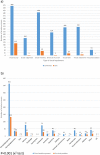High incidence and prevalence of visual problems after acute stroke: An epidemiology study with implications for service delivery
- PMID: 30840662
- PMCID: PMC6402759
- DOI: 10.1371/journal.pone.0213035
High incidence and prevalence of visual problems after acute stroke: An epidemiology study with implications for service delivery
Abstract
Background: Visual problems are an under-reported sequela following stroke. The aim of this study is to report annual incidence and point prevalence of visual problems in an acute adult stroke population and to explore feasibility of early timing of visual assessment.
Methods and findings: Multi-centre acute stroke unit, prospective, epidemiology study (1st July 2014 to 30th June 2015). Orthoptists reviewed all patients with assessment of visual acuity, visual fields, ocular alignment, ocular motility, visual inattention and visual perception. 1033 patients underwent visual screening at a median of 3 days (IQR 2) and full visual assessment at a median of 4 days (IQR 7) after the incident stroke: 52% men, 48% women, mean age 73 years and 87% ischaemic strokes. Excluding pre-existent eye problems, the incidence of new onset visual sequelae was 48% for all stroke admissions and 60% in stroke survivors. Three quarters 752/1033 (73%) had visual problems (point prevalence): 56% with impaired central vision, 40% eye movement abnormalities, 28% visual field loss, 27% visual inattention, 5% visual perceptual disorders. 281/1033 (27%) had normal eye exams.
Conclusions: Incidence and point prevalence of visual problems in acute stroke is alarmingly high, affecting over half the survivors. For most, visual screening and full visual assessment was achieved within about 5 days of stroke onset. Crucial information can thus be provided on visual status and its functional significance to the stroke team, patients and carers, enabling early intervention.
Conflict of interest statement
The authors have declared that no competing interests exist.
Figures





References
-
- Hepworth LR, Rowe FJ, Walker MF, Rockliffe J, Noonan C, Howard C, et al. Post-stroke visual impairment: A systematic literature review of types and recovery of visual conditions. Ophthalmology Research. 2016;5 10.9734/OR/2016/21767 - DOI
-
- Isaeff WB, Wallar PH, Duncan G. Ophthalmic findings in 322 patients with a cerebral vascular accident. Annals of Ophthalmology. 1974;6:1059–1064 - PubMed
-
- Freeman CF, Rudge NB. The orthoptist's role in the management of stroke patients. 6th International Orthoptic Congress. 1987:333–337
-
- Clisby C. Visual assessment of patients with cerebrovascular accident on the elderly care wards. British Orthoptic Journal. 1995;52:38–40
Publication types
MeSH terms
Grants and funding
LinkOut - more resources
Full Text Sources
Medical

